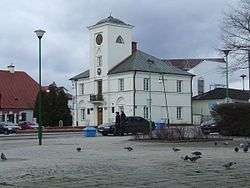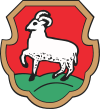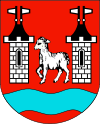Piaseczno
| Piaseczno | |||
|---|---|---|---|
|
Old Town Hall | |||
| |||
 Piaseczno | |||
| Coordinates: 52°4′0″N 21°1′0″E / 52.06667°N 21.01667°E | |||
| Country |
| ||
| Voivodeship | Masovian | ||
| County | Piaseczno County | ||
| Gmina | Gmina Piaseczno | ||
| Established | 14th century | ||
| Town rights | 1429 | ||
| Government | |||
| • Mayor | Zdzisław Lis | ||
| Area | |||
| • Total | 16.33 km2 (6.31 sq mi) | ||
| Population (2015) | |||
| • Total | 43,540 | ||
| • Density | 2,700/km2 (6,900/sq mi) | ||
| Time zone | CET (UTC+1) | ||
| • Summer (DST) | CEST (UTC+2) | ||
| Postal code | 05-500 | ||
| Area code(s) | +48 022 | ||
| Car plates | WPI | ||
| Website | http://www.piaseczno.eu/ | ||

Piaseczno [pʲaˈsɛt͡ʂnɔ] is a town in central Poland with 43,540 inhabitants (2015). It is situated in the Masovian Voivodeship, approximately 16 kilometres (10 miles) south of Warsaw. It is a popular residential area and a suburb of Warsaw and is strongly linked to the capital, both economically and culturally. It is the capital of Piaseczno County.
History
Early History
The origins of the city dates from a village in the 13th century when it was part of Bohemia, located on the route between Warsaw and Czerskiem. Its strategic position meant that the village grew quickly. On 5 November 1429 the town obtained a charter, and soon became a local market. A further charter was confirmed in 1461.[1]
In 1537 the town became Royal property and in the second half of the 16th century reached 1200 inhabitants based round the brewing and transport industries.[1] However, the city suffered setbacks because of numerous fires in the late 16th and early 17th centuries but returned to its former glory in the first half of the 18th century.
The town church was built in 1736 by architect Carl Frederick Pöppelmann and during the second partition of Poland the city was burned during the Battle of Gołków which took place on 9 and 10 July 1794. Only a church and few houses survived.
Napoleonic Wars
From 1806 to 1807 a French cavalry unit was stationed in the town as part of the Napoleonic wars, and from 1808 to 1811 this was replaced by the Polish 1st Regiment mounted rifles. The Congress of Vienna, saw the area ceded to Russia in 1815.
In 1825 the road from Warsaw and shortly afterward the railway improved links to Warsaw as a result Piaseczno experienced a period of economic recovery.
World War 1
In September and October 1914 Piaseczno was the site of fierce fighting between German and Russian Forces in the battle for Warsaw. In May 1917, the new City Council held its first council meeting and in November 1918 German gendarmerie surrendered.
On June 4, 1928, Polish President Ignacy Mościcki laid the cornerstone for the folk house and in 1933 Marshal Józef Piłsudski was made an honorary citizen of the city.
World War II
World War II began for the city on 9 and 10 September 1939, when the Polish 54 light artillery regiment fought a skirmish with a German armored division. The Nazi Occupation ended on January 17, 1945, when 1st Armored Brigade entered the city without a fight.
In 1940, during the Nazi Occupation of Poland, German authorities established a Jewish ghetto in Piaseczno,[2] in order to confine its Jewish population for the purpose of persecution and exploitation.[3] The ghetto was liquidated in January 1941, when all its 2,500 inhabitants were transported in cattle trucks to the Warsaw Ghetto, the largest ghetto in all of Nazi occupied Europe with over 400,000 Jews crammed into an area of 1.3 square miles (3.4 km2). From there, most victims were sent to Treblinka extermination camp.[4][5][6][7]
Town Hall
The original Town Hall was burned down in 1655 by the Swedes during the deluge. The second accidentally burned down in 1730. A third Town Hall was constructed in the middle of the 18th century but was burned down during the Kościuszko Uprising in 1794. In 1815 the Russians began rebuilding it and the current Town hall was built in a classical style between 1823-1824.
Religious communities
For some time the town of Piaseczno had a diverse religious community.
- In 1820 there were 893 inhabitants, of whom 171 were Jews (about 19%).
- The 1897 census showed Piaseczno had 2760 inhabitants with 41.5% Catholics, 40% Jewish and 17.9% protestant.[8]
- In 1918 there were 6956 people in the town. Catholics were about 40%, Jews about 56% and sizable protestant and Orthodox populations also existed.
As stated above, the Jewish community was deported to the Warsaw Ghetto in 1940.
Piaseczno was the seat of a Hasidic dynasty founded by Rabbi Kalonymus Kalman Shapiro, currently maintained by his extended family in Israel.
Modern Landmarks
- Piaseczno Town Hall
- Church of St. Anna
- The parish cemetery (1795)
- Jewish bath.
- The Jewish cemetery
- Former Piaseczno Ghetto[9]
- Memorial to Warsaw Uprising participants executed in Piaseczno
International relations
Twin towns — Sister cities
Piaseczno is twinned with:
 Upplands Vasby, Sweden
Upplands Vasby, Sweden Harku Parish, Estonia
Harku Parish, Estonia Novohrad-Volynskyi, Ukraine
Novohrad-Volynskyi, Ukraine Guadix, Spain
Guadix, Spain
Notes and references
- 1 2 E. i W. Bagińscy, Szkice z dziejów Miasta Piaseczna, wyd. OK Piaseczno, 2004, p 5-6.
- ↑ The statistical data compiled on the basis of "Glossary of 2,077 Jewish towns in Poland" by Virtual Shtetl Museum of the History of the Polish Jews (English), as well as "Getta Żydowskie," by Gedeon, (Polish) and "Ghetto List" by Michael Peters at www.deathcamps.org/occupation/ghettolist.htm (English). Accessed July 12, 2011.
- ↑ "The War Against The Jews." The Holocaust Chronicle, 2009. Chicago, Il. Accessed June 21, 2011.
- ↑ Warsaw Ghetto, United States Holocaust Memorial Museum (USHMM), Washington, D.C.
- ↑ Richard C. Lukas, Out of the Inferno: Poles Remember the Holocaust, University Press of Kentucky 1989 - 201 pages. Page 13; also in Richard C. Lukas, The Forgotten Holocaust: The Poles Under German Occupation, 1939-1944, University Press of Kentucky, 1986, Google Print, p.13.
- ↑ Gunnar S. Paulsson, "The Rescue of Jews by Non-Jews in Nazi-Occupied Poland," Journal of Holocaust Education, Vol.7, Nos.1&2, 1998, pp.19-44. Published by Frank Cass, London.
- ↑ Edward Victor, "Ghettos and Other Jewish Communities." Judaica Philatelic. Accessed June 20, 2011.
- ↑ Ewangelicyzm w Gminie Piaseczno
- ↑ Ewa Bagieńska, Włodzimierz Bagieński: Szkice z dziejów miasta Piaseczna. 2001
External links
![]() Media related to Piaseczno at Wikimedia Commons
Media related to Piaseczno at Wikimedia Commons
- County Piaseczno website
- Piaseczno - Local information Police, Hotel, Restaurant
- Local News Service
- Jewish Community in Piaseczno on Virtual Shtetl
Coordinates: 52°04′N 21°01′E / 52.067°N 21.017°E



